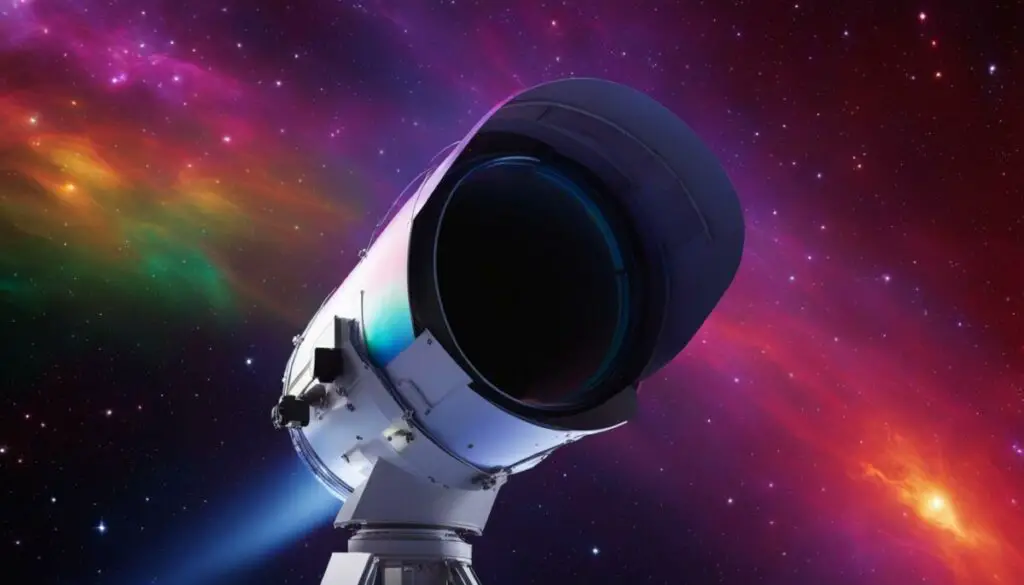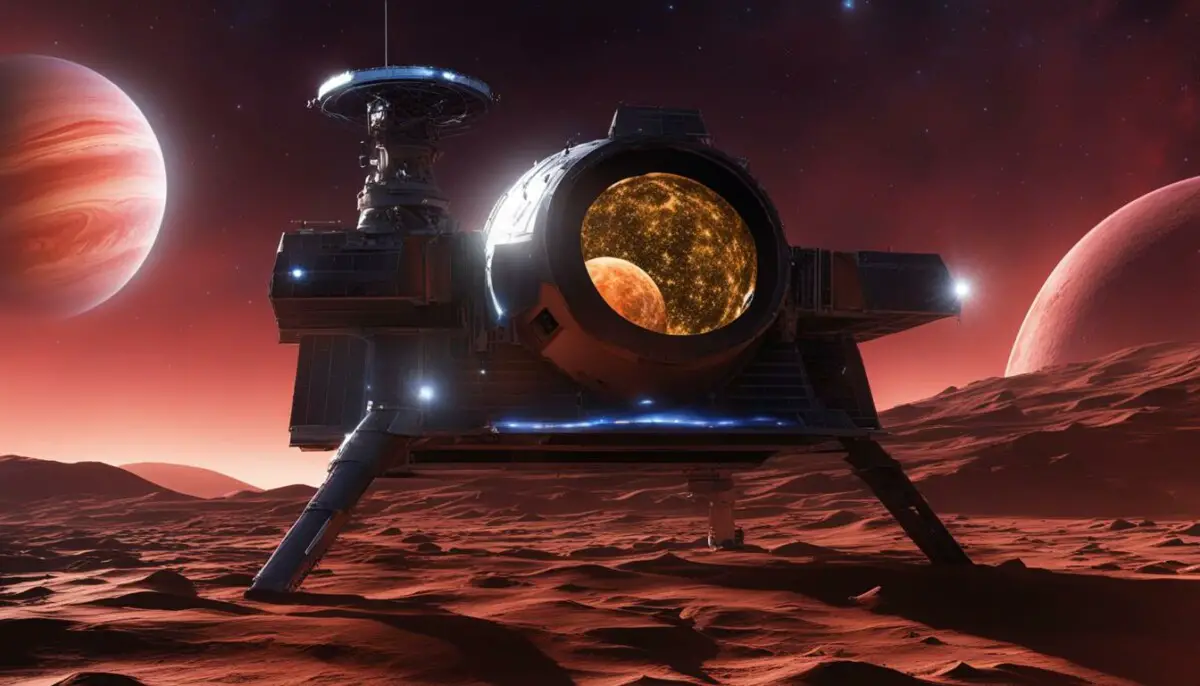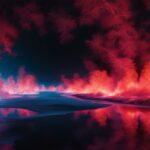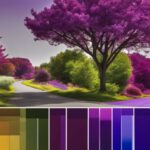Last Updated on 5 months by Francis
Spectroscopy and infrared technology have proven to be invaluable tools in space exploration. These advanced technologies allow scientists to gather essential data about distant objects and celestial phenomena. By studying the electromagnetic spectrum beyond what the human eye can see, astronomers can unlock cosmic mysteries and gain a deeper understanding of the universe. In this article, we will delve into the applications and benefits of spectroscopy and infrared technology in space research.
Contents
Key Takeaways:
- Spectroscopy and infrared technology provide crucial insights into the composition and physical properties of celestial objects.
- Infrared technology enables the observation of cool objects and hidden details in space that would be invisible in visible light.
- Space telescopes equipped with infrared instruments overcome atmospheric limitations and provide clearer and more accurate data.
- Spectroscopy and infrared technology contribute to advancements in our understanding of planetary systems, star formation, and the early universe.
- As technology continues to advance, we can expect even more remarkable discoveries and breakthroughs in space exploration.
The Importance of Spectroscopy in Space Exploration
Spectroscopy has become an indispensable tool in space exploration, enabling scientists to unlock the secrets of the universe. By analyzing the spectral properties of light emitted or absorbed by celestial bodies, spectroscopy provides valuable information about their composition, temperature, and other critical characteristics. This information helps us gain a deeper understanding of distant objects and phenomena that are key to unraveling the mysteries of space.
One of the main applications of spectroscopy in space exploration is the study of planetary diversity within our solar system. By analyzing the light reflected or emitted by different planets, scientists can determine their atmospheric composition and temperatures. This knowledge is instrumental in understanding the unique features of each planet and provides insights into their formation and evolution. From the scorching heat of Venus to the frigid temperatures of Pluto, spectroscopy has allowed us to paint a detailed picture of the diverse worlds within our cosmic neighborhood.
“Spectroscopy provides a window into the unseen, revealing the hidden composition of celestial objects and expanding our understanding of the universe.”
Furthermore, spectroscopy has been crucial in the discovery and characterization of exoplanets – planets that orbit stars outside our solar system. By analyzing the light passing through the atmospheres of these distant worlds, astronomers can detect the presence of gases, such as water vapor, carbon dioxide, and methane. This data helps us assess the potential habitability and possibility of life on other planets. The advancements in spectroscopy continue to push the boundaries of our knowledge, opening new avenues for exploration and expanding our understanding of the cosmos.
| Spectroscopy in Space Exploration | Advancements | Applications |
|---|---|---|
| Astronomical spectroscopy | Improved sensitivity and resolution | Studying planetary diversity |
| Exoplanet characterization | Detection of atmospheric gases | Assessing habitability |
| Stellar evolution studies | Identification of chemical elements | Understanding star formation |
Utilizing Infrared Technology for Space Research

Infrared technology has revolutionized space research, opening up new possibilities for scientists to explore and understand the cosmos. This technology allows us to observe celestial objects that emit or reflect infrared light, providing valuable insights into the mysteries of the universe. By utilizing infrared technology in space missions, scientists can overcome the limitations posed by interstellar dust and Earth’s atmosphere, enabling clearer and more accurate observations.
One of the significant benefits of infrared technology in space research is its ability to penetrate interstellar dust. Unlike visible light, which can be absorbed or scattered by dust particles, infrared radiation can pass through these obstacles. This capability allows astronomers to detect and study cool objects that are otherwise invisible, such as brown dwarfs and protostars. Infrared telescopes, like the James Webb Space Telescope, have the power to peer into dusty regions of space, revealing hidden details of star-forming regions, exoplanets, and other astronomical phenomena.
Infrared technology also plays a critical role in studying planetary atmospheres and their compositions. Different molecules and atoms emit or absorb infrared radiation at distinct wavelengths, allowing scientists to identify and analyze various components in space. By studying the infrared signatures of molecules and dust particles, astronomers can gain insights into the temperature, composition, and physical properties of celestial objects. This information contributes to our overall understanding of planetary systems, star formation, and galaxy evolution.
Overall, utilizing infrared technology in space research has transformed our understanding of the universe. It has allowed us to discover and explore a hidden universe that would otherwise remain invisible. By overcoming the challenges posed by interstellar dust and Earth’s atmosphere, infrared technology has provided scientists with invaluable data and insights. As technology continues to advance, we can expect even more remarkable discoveries and breakthroughs in the future.
The Discovery and Role of Infrared Light

Infrared light, first discovered by Sir William Herschel around 200 years ago, plays a unique role in space exploration. It extends beyond the red part of the visible spectrum and allows scientists to study objects and phenomena that emit or reflect infrared radiation. By analyzing the infrared signatures of molecules and dust particles, astronomers can gain insights into the composition, temperature, and physical properties of celestial objects.
Infrared technology has revolutionized our understanding of space. It enables us to observe objects that are cool and do not emit much visible light, such as brown dwarfs and protostars. By studying the infrared radiation from distant galaxies, we can delve into the early days of the universe and explore questions about dark matter, black holes, and galaxy evolution. Infrared observations provide a unique window into the mysteries of the cosmos and contribute significantly to our overall understanding of space.
The discovery of infrared light has allowed us to uncover a hidden universe that is not visible in other parts of the spectrum. It has expanded our knowledge of planetary systems, star formation, and the evolution of galaxies. Infrared technology has opened up new avenues for exploration and discoveries in the vast expanse of space.
Unlocking the Secrets of the Universe
- Analysis of infrared light helps identify and analyze various components in space, including interstellar gas, dust clouds, and exoplanet atmospheres.
- Infrared observations penetrate through interstellar dust particles, revealing hidden details of star-forming regions and other astronomical phenomena.
- By combining infrared observations with other parts of the electromagnetic spectrum, astronomers obtain a more comprehensive understanding of the universe.
By harnessing the power of infrared technology, scientists continue to make significant discoveries and advancements in the field of space exploration. As our understanding of the universe expands, we can expect even more remarkable revelations and breakthroughs in the future.
The Electromagnetic Spectrum and Space Telescopes

Space telescopes play a crucial role in observing the universe beyond the capabilities of ground-based telescopes. They are designed to detect and capture light in various parts of the electromagnetic spectrum, including the infrared region. The electromagnetic spectrum encompasses a wide range of wavelengths, ranging from gamma rays to radio waves. Each portion of the spectrum provides unique insights into different physical processes and phenomena in space.
The utilization of space telescopes has revolutionized our understanding of the cosmos. By combining observations from different parts of the spectrum, astronomers can obtain a more comprehensive view of celestial objects and unravel their mysteries. Infrared telescopes, in particular, have been instrumental in studying cool objects and dusty regions of space that are not visible in other parts of the spectrum. They have enabled the detection of brown dwarfs, protostars, and other objects that emit or reflect infrared radiation.
One of the most significant space telescopes that utilize infrared technology is the James Webb Space Telescope (JWST). It is set to launch in 2021 and promises to revolutionize our understanding of the universe. The JWST will be able to peer through dusty regions of space and capture high-resolution images and spectroscopic data, providing unprecedented views of distant galaxies, star-forming regions, and exoplanets. Its advanced capabilities in the infrared range will enable scientists to study the early universe and investigate the formation and evolution of galaxies.
Advantages of Infrared Observations
Infrared observations have distinctive advantages in space exploration. They allow scientists to penetrate dust clouds and study objects that would otherwise be hidden from view. Infrared radiation provides valuable information about the temperature and composition of celestial bodies. By analyzing the infrared signatures of molecules and atoms, astronomers can identify and analyze various components in space, such as interstellar gas, dust clouds, and even exoplanet atmospheres.
Furthermore, infrared observations contribute to our understanding of the universe’s history. By studying the infrared radiation from distant galaxies, scientists can investigate the early stages of galaxy formation and evolution. Infrared observations also help in the search for potential signs of life on exoplanets. The presence of certain molecules in an exoplanet’s atmosphere, such as water vapor or methane, can indicate the possibility of biological activity.
The Power of Space Telescopes
Space telescopes equipped with infrared technology have unlocked a hidden universe that is not visible in other parts of the spectrum. They have allowed us to study cool objects, explore star-forming regions, and investigate the mysteries of the early universe. The data collected by these telescopes provide valuable insights into the composition, temperature, and physical properties of celestial objects, contributing to our ever-growing knowledge of the cosmos.
The Power of Infrared Observations

Infrared observations play a crucial role in space exploration, providing scientists with unique insights into the universe. By detecting and analyzing infrared light emitted or absorbed by celestial objects, astronomers can uncover valuable information about their composition, temperature, and physical properties. Unlike visible light, infrared radiation can penetrate dusty regions of space, allowing us to study objects that would otherwise be hidden.
One of the key advantages of infrared observations is their ability to reveal details about celestial bodies that emit little visible light. Cool objects like brown dwarfs and protostars, which are difficult to detect in other parts of the spectrum, can be observed in the infrared. This opens up new possibilities for studying the formation and evolution of stars and planetary systems.
Infrared technology also enables astronomers to study interstellar gas and dust clouds, as well as the atmospheres of exoplanets. Different molecules and atoms emit or absorb infrared radiation at specific wavelengths, providing a fingerprint that helps scientists identify and analyze these components. By studying the infrared signatures of various substances in space, researchers can gain a deeper understanding of the chemical makeup and physical processes occurring within the universe.
The Versatility of Infrared Observations
Infrared observations have proven to be versatile across a wide range of astronomical studies. They have allowed scientists to investigate the formation and dynamics of galaxies, explore the early universe, and study the properties of distant stellar objects. By combining observations from different parts of the electromagnetic spectrum, astronomers can obtain a more comprehensive view of the cosmos and uncover new insights into its workings.
The power of infrared observations lies in their ability to provide a unique perspective on the universe. By overcoming the limitations of visible light and penetrating the dusty regions of space, infrared technology has opened up new frontiers in our exploration of the cosmos. With further advancements in technology and the launch of upcoming space telescopes, we can expect even more remarkable discoveries and a deeper understanding of the universe through infrared observations.
Table: Applications of Infrared Observations in Space Exploration
| Application | Description |
|---|---|
| Studying planetary atmospheres | Infrared observations help characterize the compositions and temperatures of atmospheres in our solar system and beyond. |
| Exploring star formation | Infrared technology allows scientists to study the birth and evolution of stars, including the formation of protostellar disks. |
| Investigating galaxy evolution | By observing the infrared emissions of distant galaxies, astronomers can trace the evolution of galaxies throughout cosmic history. |
| Detecting exoplanets | Infrared observations aid in the detection and characterization of exoplanets, providing valuable insights into their atmospheres and potential habitability. |
| Uncovering the early universe | Infrared observations shed light on the early stages of the universe, helping scientists understand the formation of galaxies and the cosmic web. |
The Hidden Universe Revealed by Infrared
Infrared technology has unlocked a hidden universe that was once invisible to our eyes and other parts of the electromagnetic spectrum. By detecting and analyzing infrared radiation, astronomers have been able to observe objects and phenomena that emit or reflect infrared light, revealing a wealth of information about the cosmos. From cool and dim objects like brown dwarfs and protostars to distant galaxies in the early universe, the infrared spectrum has provided a unique window into the mysteries of space.
One of the key advantages of infrared observations is the ability to see through dusty regions of space, which would otherwise obscure our view. Infrared light can penetrate interstellar dust particles, allowing us to study objects that are invisible in other parts of the spectrum. This has led to significant discoveries, such as the detection of exoplanets and the mapping of star formation regions within our own galaxy. Infrared observations also provide insights into the composition and temperature of celestial bodies, helping scientists unravel the complex processes that shape our universe.
Infrared technology has allowed us to uncover a hidden universe that is not visible in other parts of the spectrum.
Furthermore, the study of infrared radiation from distant galaxies has deepened our understanding of the early universe. By analyzing the infrared emissions of these galaxies, astronomers can trace the formation and evolution of stars and galaxies billions of years ago. Infrared observations have provided evidence for the existence of dark matter, revealed the presence of supermassive black holes at the centers of galaxies, and shed light on the intricate processes that drive galaxy evolution. These findings have challenged and expanded our understanding of the cosmos, shaping the course of modern astrophysics.
In conclusion, infrared technology has transformed our understanding of the universe by revealing a hidden realm of cosmic objects and phenomena. Through the power of infrared observations, scientists have explored the depths of space, unraveling the mysteries of star formation, exoplanets, distant galaxies, and the early universe. The unique capabilities of infrared technology have allowed us to see beyond what the human eye can perceive, opening up new frontiers in space exploration and expanding our knowledge of the cosmos.
Overcoming Atmospheric Challenges with Infrared Technology
Observing space from Earth poses unique challenges due to the Earth’s atmosphere. The atmosphere absorbs and produces its own infrared radiation, which can interfere with accurate observations of celestial objects. However, scientists have developed innovative solutions to overcome these atmospheric limitations using infrared technology in space.
By utilizing space-based infrared telescopes and instruments, astronomers can bypass the interference caused by Earth’s atmosphere and obtain clearer and more accurate data. These telescopes provide a direct view of celestial objects in the infrared spectrum, enabling higher-resolution and more sensitive observations. With the absence of atmospheric distortion, scientists can study celestial objects with greater precision and reveal intricate details that would otherwise be obscured.
Benefits of Infrared Technology in Space
Space-based infrared technology offers numerous advantages for space exploration. It allows astronomers to peer through dusty regions of space that would otherwise block visible light, providing a clearer view of cool objects such as brown dwarfs and protostars. Infrared observations also reveal valuable information about the temperature and composition of celestial bodies, enabling scientists to analyze interstellar gas, dust clouds, and even the atmospheres of exoplanets. Infrared technology has become an indispensable tool for studying the hidden universe and advancing our understanding of space.
Enhancing Our Knowledge of the Cosmos
By overcoming atmospheric challenges with infrared technology, scientists can continue to expand our knowledge of the universe. Space-based infrared observations have unveiled new insights into planetary systems, star formation, galaxy evolution, and the early universe. These advancements in spectroscopy and infrared technology have allowed us to explore questions about dark matter, black holes, and the origins of galaxies. As technology continues to advance, we can look forward to further discoveries and breakthroughs in the field of space exploration.
Advancing Our Understanding of the Universe
The advancements in spectroscopy and infrared technology have propelled space exploration to new heights, revolutionizing our understanding of the universe. These cutting-edge technologies have not only expanded our knowledge but also paved the way for remarkable discoveries and scientific advancements.
The Power of Spectroscopy
Spectroscopy has played a pivotal role in unraveling the mysteries of space. By analyzing the light emitted or absorbed by celestial objects, scientists can determine their composition, temperature, and other crucial characteristics. Spectroscopic observations have led to breakthroughs in our understanding of planetary atmospheres, star formation, and the evolution of galaxies.
With advancements in spectroscopic techniques, scientists can now study distant objects in unprecedented detail, revealing intricate features and shedding light on cosmic phenomena. By constantly pushing the boundaries of technology, researchers continue to unlock valuable insights into the vastness of the universe.
The Revolution of Infrared Technology
Infrared technology has been a game-changer in space exploration. By detecting and capturing infrared radiation, astronomers can peer through dust clouds and observe cool, hidden objects that are otherwise invisible. This has opened up new windows of discovery, allowing us to study brown dwarfs, protostars, and even the early stages of galaxy formation.
The use of infrared technology in space telescopes has overcome the limitations posed by Earth’s atmosphere, providing clearer and more precise observations. With state-of-the-art instruments like the James Webb Space Telescope, scientists can delve deeper into the secrets of the universe and gain unprecedented insights into its vastness.
Pushing the Boundaries
The advancements in spectroscopy and infrared technology have propelled space exploration to new frontiers, pushing the boundaries of human knowledge. By continuously innovating and refining these technologies, scientists are able to gather invaluable data and make significant leaps in our understanding of the cosmos.
As we continue to explore the universe, it is certain that spectroscopy and infrared technology will play an integral role in unlocking its secrets and unraveling the mysteries that lie beyond our reach.
Conclusion
Spectroscopy and infrared technology have proven to be invaluable tools in space exploration, enabling scientists to gather essential data about distant objects and celestial phenomena. By studying the electromagnetic spectrum beyond what the human eye can see, astronomers have unlocked cosmic mysteries and gained a deeper understanding of the universe.
From the applications of spectroscopy in determining the composition and characteristics of celestial bodies, to the utilization of infrared technology in observing objects that emit or reflect infrared light, these advancements have revolutionized space research. Infrared observations have revealed a hidden universe that is not visible in other parts of the spectrum, allowing us to explore protostars, brown dwarfs, and the early days of the universe.
Moreover, by overcoming atmospheric challenges with space-based infrared telescopes and instruments, astronomers have obtained clearer and more accurate data. These advancements in spectroscopy and infrared technology have greatly advanced our understanding of the universe, expanding our knowledge of planetary systems, star formation, galaxy evolution, and the early universe.
As technology continues to evolve, we can anticipate even more remarkable discoveries and breakthroughs in the future. Spectroscopy and infrared technology will continue to play a pivotal role in unraveling the mysteries of space and pushing the boundaries of our knowledge.
FAQ
How can spectroscopy and infrared technology be useful in space?
Spectroscopy and infrared technology are invaluable tools in space exploration, allowing scientists to gather essential data about distant objects and celestial phenomena. By studying the electromagnetic spectrum beyond what the human eye can see, astronomers can unlock cosmic mysteries and gain a deeper understanding of the universe.
What are the applications of spectroscopy in space?
Spectroscopy plays a crucial role in space exploration by providing compositional information about distant objects. By analyzing the spectral properties of light emitted or absorbed by celestial bodies, scientists can determine their temperature, atmospheric composition, and other critical characteristics. Infrared spectroscopy has been particularly useful in studying planetary diversity within our solar system.
How does infrared technology revolutionize space research?
Infrared technology allows scientists to observe celestial objects that emit or reflect infrared light, which can pass through obstacles like interstellar dust. This technology has opened up new avenues for exploration and discoveries in the cosmos, revealing hidden details of star-forming regions, exoplanets, and other astronomical phenomena.
What is the role of infrared light in space exploration?
Infrared light has a unique role in space exploration, allowing us to study objects and phenomena that emit or reflect infrared radiation. By analyzing the infrared signatures of molecules and dust particles, scientists can gain insights into the composition, temperature, and physical properties of celestial objects.
How do space telescopes utilize the electromagnetic spectrum?
Space telescopes, such as the James Webb Space Telescope, are designed to detect and capture light in the infrared and other non-visible wavelengths. These telescopes provide detailed observations of celestial objects across the electromagnetic spectrum, allowing scientists to study various physical processes and phenomena in space.
What advantages do infrared observations offer in space exploration?
Infrared observations have unique advantages in space exploration. They can penetrate dust particles, revealing details about the temperature and composition of celestial bodies. This helps astronomers identify and analyze various components in space, such as interstellar gas, dust clouds, and exoplanet atmospheres.
What has infrared technology allowed us to uncover in space?
Infrared technology has allowed us to uncover a hidden universe that is not visible in other parts of the spectrum. It has enabled the detection of cool objects like brown dwarfs and protostars, as well as the study of infrared radiation from distant galaxies, shedding light on the early days of the universe and exploring questions about dark matter, black holes, and galaxy evolution.
How does infrared technology overcome atmospheric challenges in observing space?
Observing space from Earth poses challenges due to the Earth’s atmosphere, which absorbs and produces its own infrared radiation. By utilizing infrared technology in space, astronomers can obtain clearer and more accurate data. Space-based infrared telescopes and instruments provide a more direct view of celestial objects without the interference caused by Earth’s atmosphere.
How have spectroscopy and infrared technology advanced our understanding of the universe?
Spectroscopy and infrared technology have greatly contributed to our understanding of the universe by providing detailed data about celestial objects. They have expanded our knowledge of planetary systems, star formation, galaxy evolution, and the early universe. By constantly pushing the boundaries of technology and exploring new observational techniques, scientists continue to make significant discoveries and advancements in the field of space exploration.
What is the conclusion on spectroscopy and infrared technology in space?
Spectroscopy and infrared technology have revolutionized space exploration, allowing us to delve deeper into the mysteries of the universe. These tools have provided invaluable data about celestial objects, their composition, and their physical properties. As technology continues to advance, we can expect even more remarkable discoveries and breakthroughs in the future.








